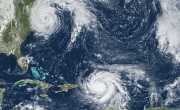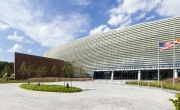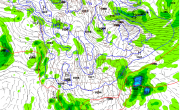Autumn 2014 | Announcements, Publications and More VISITOR PROJECT AWARDS Paul Roebber (Univ of Wisconsin - Milwaukee):Demonstration Project: Development of a Large Member Ensemble Forecast System for Heavy Rainfall using Evolutionary Programming. WORKSHOPS, TUTORIALS, EVENTS Physics Workshop The DTC and NOAA will convene a workshop entitled ‘Parameterization of moist process for next-generation numerical weather prediction… Read More
Lead Story: The need for a Common Community Physics Package
Summer 2016 | While national modeling centers can benefit from the expertise in the broader community of parameterization developers, the social and technical barriers to a community researcher implementing and testing a new parameterization or set of parameterizations (a physics suite) in an operational model are high. Physical parameterization codes are often implemented so that they are strongly linked to a particular model dynamical core, with dependencies on grid structure, prognostic variables, and even time-… Read More
Lead Story: Evaluating WRF performance over time
Autumn 2014 | As modifications and additions are made to WRF code and released to the community, users often ask, “Is WRF really improving?”
Director's Corner: Kevin Kelleher
Kevin Kelleher, NOAA GSD
Autumn 2014 | During my first 15 months as the ESRL Global Systems Division Director, I have learned about the DTC and its role in the modeling community. The DTC has made remarkable gains in supporting the WRF model within the community that has contributed to the great success and usage of the model both nationally and internationally. I believe the DTC is unique in how it is funded and operated as a joint effort between NCAR and NOAA, along with partners from the Air Force. It is my observation that there is a significant effort to… Read More
Who's Who: Kathryn Newman

Autumn 2016 | As a Junior Atmospheric Science major, at the University of North Dakota (UND), Kathryn Newman organized 25 weather labs for hundreds of aviation students that were required to take Meteorology (ATSC 110). The multi-tasking and organizational skills she developed come in handy as the DTC Hurricane Task Lead to oversee transitioning Hurricane Task research to EMC. “It’s challenging to keep track of all the moving parts in modeling research and getting them into operations,” she says, “But it is cool to be involved at this… Read More
Visitors: Harnessing the Power of Evolution for Weather Prediction
Visitor: Paul Roebber
Summer 2016 | As a DTC Visitor in 2015, Paul Roebber explored an idea for generating ensemble weather predictions known as evolutionary programming (EP). The method relies on a gradually and increasingly restrictive cost function to produce and to evaluate succeeding generations of a population of algorithms until such time as a best ensemble solution is determined based on cross-validation. The approach was developed by Roebber to produce baseline prediction equations equivalent to linear or nonlinear multiple regression… Read More
Did you know?: Did you know there are suggested topics for Visitor Projects that receive special consideration?
Autumn 2016 | Advance the forecast skill of the DTC-supported HWRF modeling system through improved physics and/or initialization Advance the analysis capability of the DTC-supported Gridpoint Statistical Interpolation and/or the NOAA Ensemble Kalman Filter (EnKF) Data Assimilation systems through development, testing, and evaluation of advanced data assimilation techniques and the addition of new data types or measurements Transition innovations in atmospheric physical parameterizations to NOAA’s Next-Generation Global… Read More
Software Release: Release v3.9a of the HWRF system
Proposals for Contributions Encouraged

2017-10-16 | The Developmental Testbed Center (DTC) is pleased to announce the release of version 3.9a of the community HWRF modeling system. The release includes all components of the system: scripts, data preprocessing, vortex initialization, data assimilation, atmospheric and ocean models, coupler, postprocessor, and vortex tracker. Both the Scientific Documentation and the Users Guide have been updated.… Read More
Announcement: 2018 Hurricane WRF Tutorial
Registration Now Open

Autumn 2017 | The DTC is pleased to announce that registration is now open for the 2018 Hurricane WRF (HWRF) tutorial to be held 23–25 January 2018 at the NOAA Center for Weather and Climate Prediction (NCWCP) in College Park, MD. Registration, a draft agenda, and information about hotel accommodations and other logistics can be found on our tutorial website: 2018 HWRF tutorial The HWRF tutorial will be a three-day event organized by the Developmental Testbed Center (DTC) and by the NOAA Environmental Modeling Center (EMC… Read More
Software Release: Release of GSI Version 3.6 and EnKF Version 1.2
Release Date 10.04.2017

Autumn 2017 | The Developmental Testbed Center (DTC) is pleased to announce the release of the following community data assimilation systems: Version 3.6 of the Community Gridpoint Statistical Interpolation (GSI) data assimilation system Version 1.2 of the Community Ensemble Kalman Filter (EnKF) data assimilation system The released packages for GSI and EnKF and the documentation for each can be accessed through each system website as… Read More
Software Release: Release of the MET version 6.0 Verification Package
Software Releases

Summer 2017 | The MET development team at the DTC is pleased to announce the release of the MET version 6.0 verification package. It is available for download from the MET Users web page. The MET development team significantly enhanced the run-time performance of a number of tools, enhanced the data and file format capabilities, and added new capabilities for point observations, gridded analyses and tropical cyclone and probabilistic verification. Full details about the changes for this new… Read More
Lead Story: Community Modeling Workshop Outcome

Summer 2017 | “The most common feedback from the workshop participants noted the increase in transparency within the EMC and NOAA at large, the increasing effort to engage the entire community, and the general sense of positive momentum of the community coming together to embrace the opportunity to use NGGPS as a foundation to build a true community modeling resource for the Nation.”
Pagination
Copyright © 2026. All rights reserved.